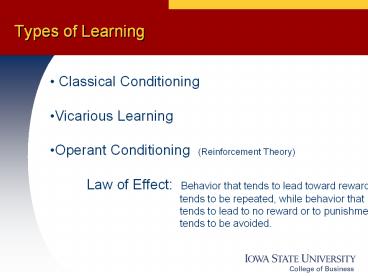Types of Learning - PowerPoint PPT Presentation
1 / 11
Title:
Types of Learning
Description:
Operant Conditioning (Reinforcement Theory) ... Rule 2: Failure to respond has reinforcing consequences. Rule 3: Tell a person what behavior gets reinforced ... – PowerPoint PPT presentation
Number of Views:11
Avg rating:3.0/5.0
Title: Types of Learning
1
Types of Learning
- Classical Conditioning
- Vicarious Learning
- Operant Conditioning (Reinforcement Theory)
- Law of Effect Behavior that tends to lead
toward rewards - tends to be repeated, while behavior
that - tends to lead to no reward or to
punishment - tends to be avoided.
2
Types of Reinforcers
Positive Negative Extinction Punishment
3
Schedules of Reinforcement
Timing of the Reinforcement
Fixed Variable
Ratio Interval
Basis for the reinforcement
4
Behavior Modification
Revise the Job
Job Analysis
Redefine desired behavior
Define measures of performance or desired
behavior
Revise Reinforcers
Set goals consequences of behavior
Revise measures
Measure actual behavior
Reinforcement
Desired Behavior
Undesired Behavior
Negative Reinforcement
Positive Reinforcement
Punishment
Extinction
Reinforcement Schedule
Review Evaluate Program
5
Rules for Using Operant Conditioning
Rule 1 Dont give the same level of
reward to all. Rule 2 Failure to respond
has reinforcing consequences Rule 3 Tell
a person what behavior gets reinforced Rule 4
Tell a person what he/she is doing
wrong Rule 5 Dont punish in front of
others Rule 6 Make consequences equal to
the behavior
6
Problems with Using Operant Conditioning
- Often dealing with competing reward systems
- Any behavior may involve multiple consequences
- Reinforcers are different from rewards
- Works only on observable, measurable behaviors
- Need to be systematic, consistent
- On the Folly of Rewarding A while Hoping for B
7
Bases for Distributing Rewards in Organizations
- Equality-Based
- Need-Based
- Time-Based
- Equity-Based
- Skill-Based
8
Conditions Needed to Pay to Motivate
- Create a belief that good performance will lead
- to high pay
- Contribute to the importance of pay
- Minimize perceived negative consequences of
- performing well
- Create conditions such that other positive
outcomes - are also related to good performance
9
Dont Tie Pay to Performance IF
- Trust is low
- Individual performance is difficult to measure
- Performance must be measured subjectively
- Large pay rewards cannot be given to the best
- performers.
10
Purposes of Reward Systems
- To motivate performance
- To attract and retain employees
- Skill Development
- Establish and maintain the organizations culture
- To define and reinforce the organizations
structure
11
Advice for Using Pay
- Decouple your thinking that labor rates (pay)
- are equivalent to labor costs.
- Think about pay in terms of how it relates to
- the companys value system.
- Think about how these values could be
- reinforced by things other than pay.

